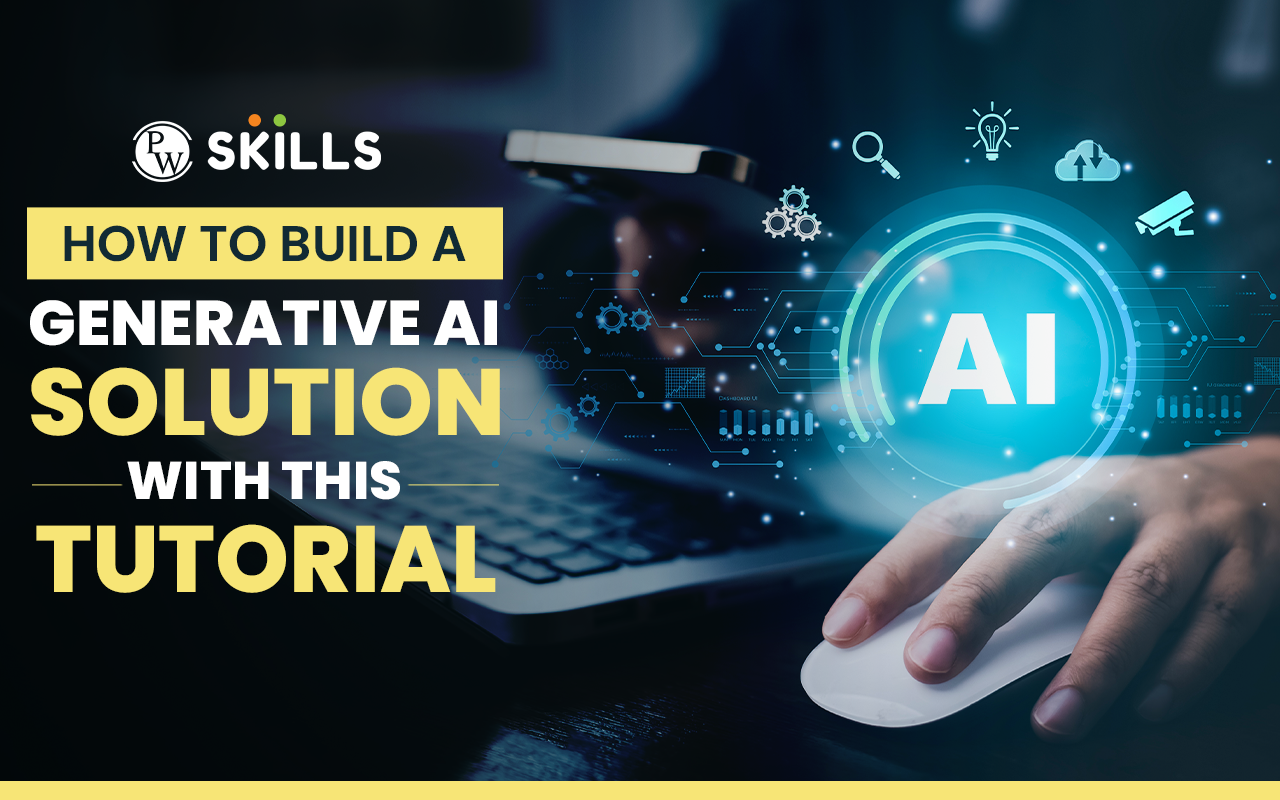Generative AI Solutions: Generative AI, a subset of artificial intelligence, has gained immense popularity for its ability to create new, realistic content autonomously. From generating art and music to crafting text and images, generative AI has found applications in various industries. In this blog, we’ll show you how to build your own generative AI solution.
If you’re looking to secure a high-paying job in generative AI, the PhysicsWallah Master Generative AI: Data Science Course is highly recommended! This course is mentored by industry experts to make sure that you’re trained by the best. Moreover, use the coupon code – “READER” during checkout to get an exclusive discount on all PW Skills courses!
What is Generative AI?
Generative AI refers to a class of algorithms that can create new content, mimicking the patterns and styles present in the training data. Traditional AI models recognize and classify patterns, but generative models concentrate on creating data. Generative Adversarial Networks (GANs) and Variational Autoencoders (VAEs) are the leading generative models.
Types of Generative Models
Generative models, the backbone of generative AI, aim to capture the underlying distribution of the training data. These models grasp data patterns, styles, and relationships to produce new samples resembling their training examples. Various generative model types exist, but the notable ones include Generative Adversarial Networks (GANs) and Variational Autoencoders (VAEs).
- Generative Adversarial Networks (GANs):
-
-
- GANs consist of two neural networks: a generator and a discriminator, engaged in a continuous adversarial process.
- The generator creates synthetic data, while the discriminator’s role is to distinguish between real and generated samples.
- Through this adversarial interplay, GANs produce outputs that closely mimic the patterns observed in the training data, resulting in high-quality and realistic content generation.
-
- Variational Autoencoders (VAEs):
-
- VAEs operate as probabilistic models that map input data into a latent space.
- The VAE encoder compresses input data into a probabilistic distribution. The decoder then reconstructs the data from samples drawn from this distribution.
- VAEs are renowned for their capacity to produce diverse outputs by sampling different points in the latent space, yielding a range of creative and unique content.
Also read: 25 Generative AI Examples in 2024 That Show AI’s Potential!
Generative AI in Action
Generative AI isn’t limited to specific data types; it applies broadly, spanning text, images, audio, and more. Consider these noteworthy instances:
- Image Generation: Generative models craft realistic images, be it faces, objects, or scenes, including those that never existed.
- Text Generation: Natural Language Processing (NLP) models using generative AI can craft coherent and contextually relevant text, leading to applications like content creation, story generation, and even chatbot responses.
- Music Composition: Generative models excel in creating original musical compositions, offering musicians and composers new avenues for exploration and inspiration.
- Style Transfer: Models can learn artistic styles from paintings and apply them to photographs, creating visually striking images with a fusion of artistic elements.
Applications of Generative AI
Generative AI has rapidly evolved into a transformative force across diverse industries, offering innovative solutions and pushing the boundaries of creativity. Here are some prominent applications that showcase the versatility and impact of generative AI:
Art and Creativity
Generative AI has become a powerful tool for artists and creators, enabling them to explore new dimensions of expression. From creating unique digital paintings to composing original music, artists leverage generative models to break free from traditional constraints. The ability to generate novel and inspiring content has redefined the creative process, fostering a collaborative partnership between human imagination and machine intelligence.
Content Generation
In the digital era, content is king, and generative AI has emerged as a game-changer for content creators. Whether it’s generating compelling text, crafting realistic images, or producing engaging videos, generative models offer a scalable and efficient means of content production. This versatility finds application in sectors like advertising, marketing, and media, where there’s an unending demand for diverse, high-quality content.
Healthcare
Generative AI has found valuable applications in the healthcare sector, particularly in medical imaging and drug discovery. In medical imaging, generative models assist in generating synthetic data for training algorithms, addressing the challenge of limited annotated datasets. Moreover, in drug discovery, generative models simulate molecular structures, aiding researchers in identifying potential drug candidates and predicting their properties.
Gaming
The gaming industry has embraced generative AI for procedural content generation, revolutionising game development. Generative models create dynamic and ever-changing virtual worlds, offering players a unique and unpredictable gaming experience. From generating landscapes and characters to crafting storylines, generative AI contributes to the creation of immersive and personalised gaming environments.
Fashion and Design
In the world of fashion, generative AI is reshaping design processes and inspiring new trends. Designers use generative models to generate innovative clothing designs, patterns, and styles. These models analyse historical fashion data, identify emerging trends, and produce novel designs that reflect a fusion of tradition and modernity. The result is a dynamic and ever-evolving landscape of fashion possibilities.
Finance and Trading
Generative AI plays a role in financial modelling, risk assessment, and algorithmic trading. In finance, generative models assist in simulating market scenarios and generating synthetic financial data for training predictive models. Traders utilise generative algorithms to analyse market patterns, identify potential risks, and make data-driven investment decisions.
Human-Computer Interaction
Generative AI contributes to enhancing human-computer interaction by creating more natural and context-aware interfaces. Chatbots and virtual assistants powered by generative models can generate human-like responses, improving user engagement and understanding. This application extends to voice synthesis and facial animation, creating more lifelike interactions between humans and machines.
Environmental Simulation
Generative models simulate environmental conditions for research, training, and testing. In domains like urban planning and autonomous vehicles, generative AI aids in crafting lifelike simulations for diverse scenarios, enabling researchers and developers to evaluate the impact of different factors on system performance.
Education and Training
Generative AI facilitates the creation of realistic simulations and training scenarios in education. From medical simulations for training healthcare professionals to virtual laboratories for science students, generative models contribute to immersive and effective learning experiences.
Cybersecurity
In the realm of cybersecurity, generative models aid in the generation of synthetic data for training intrusion detection systems. By creating diverse and realistic attack scenarios, these models assist in improving the robustness of security measures and preparing systems to defend against evolving threats.
Also read: Scope of Learning Artificial Intelligence in India 2023
Step-by-Step Guide to Building a Generative AI Solution
Now, let’s dive into the practical aspects of building a generative AI solution. Follow these steps to embark on your journey of creating innovative and autonomous content generators.
Step 1: Define Your Objective
Before diving into the technicalities, it’s crucial to define the objective of your generative AI project. Ask yourself:
- What problem do you want to solve?
- What type of content do you want to generate?
- Who is your target audience?
Having a clear objective will guide your decisions throughout the development process.
Step 2: Data Collection
The quality of your generative AI model is heavily dependent on the data it’s trained on. Consider the following:
- Collect a diverse and representative dataset relevant to your project.
- Ensure the dataset is labelled correctly.
- Address any biases in the data that might affect the model’s outputs.
Effective data collection lays the foundation for a successful generative AI solution.
Step 3: Choose the Right Model
The choice of the generative model is a critical decision that depends on your project requirements. Consider factors such as:
- The nature of the content you’re generating.
- The size of your dataset.
- Computational resources available.
GANs are suitable for generating realistic images, while VAEs might be more appropriate for capturing diverse data distributions.
Step 4: Data Preprocessing
Prepare your dataset for training by applying data preprocessing techniques:
- Normalise and standardise the data.
- Handle missing values.
- Augment the dataset to increase its size and diversity.
Effective preprocessing enhances the model’s ability to learn and generate high-quality content.
Step 5: Model Training
The training phase involves optimising the model’s parameters to generate content that aligns with your objectives. Consider:
- Experiment with different architectures.
- Fine-tune hyperparameters for optimal performance.
- Monitor the training process and adjust parameters as needed.
Training a generative model requires patience and experimentation to achieve the desired results.
Step 6: Evaluation and Validation
Assess the performance of your generative AI model through rigorous evaluation and validation:
- Use appropriate metrics to measure the quality of generated content.
- Split your dataset into training and validation sets to ensure the model generalises well.
- Iterate on the model based on feedback from the evaluation process.
Validation is essential for refining the model and enhancing its ability to generate meaningful content.
Step 7: Deployment and Maintenance
Once your generative AI model is trained and validated, it’s time to deploy it for real-world use. Consider the following:
- Choose a deployment environment that suits your project’s requirements.
- Implement mechanisms for monitoring the model’s performance in a production environment.
- Plan for regular maintenance and updates to address evolving needs and challenges.
Ensuring ethical considerations and responsible AI practices are crucial during deployment and maintenance.
Also read: Role of Artificial Intelligence in Robotics
Conclusion
Embarking on a generative AI project is an exhilarating and fulfilling journey, demanding a thoughtful approach. Following the steps in this guide empowers you to develop innovative solutions that stretch the limits of AI’s possibilities. Generative AI introduces fresh avenues for creativity and problem-solving, emerging as a valuable tool across diverse industries.
FAQs
Can Generative AI be Used in Real-Time Applications?
Certainly! Generative AI is well-suited for real-time applications like style transfer and live content generation, provided the chosen model is optimised for low-latency performance.
How Do Generative Models Address Data Privacy and Security Concerns?
To address privacy concerns, generative models implement techniques such as differential privacy and secure data handling protocols, ensuring responsible use in scenarios involving sensitive information.
Are There Limitations to the Types of Data Generative Models Can Handle?
Generative models are versatile across data types, but their effectiveness depends on data complexity. Selecting the right model and appropriate preprocessing are crucial for optimal performance.
How Can Generative AI Contribute to Sustainable Practices?
Generative AI supports sustainability by optimising processes, such as designing lightweight structures in manufacturing. This application aligns with the goal of promoting environmentally conscious practices.
What are Emerging Trends in Generative AI Development?
Emerging trends include the convergence of generative models with reinforcement learning, creating more adaptive systems. Advances in unsupervised learning and exploration of multimodal generative models are shaping the future of generative AI.





